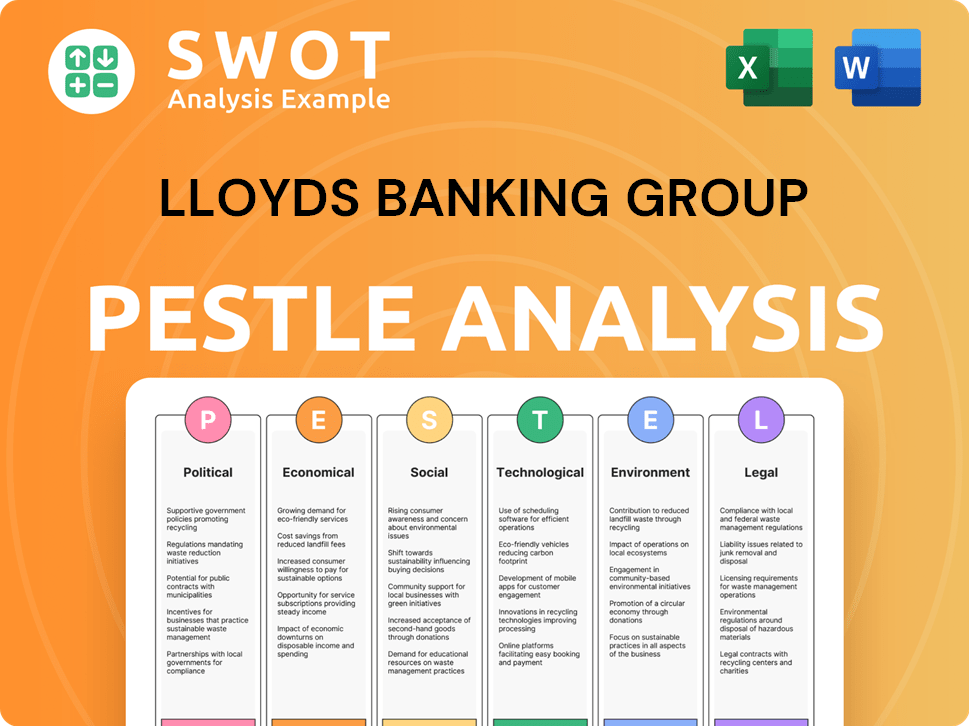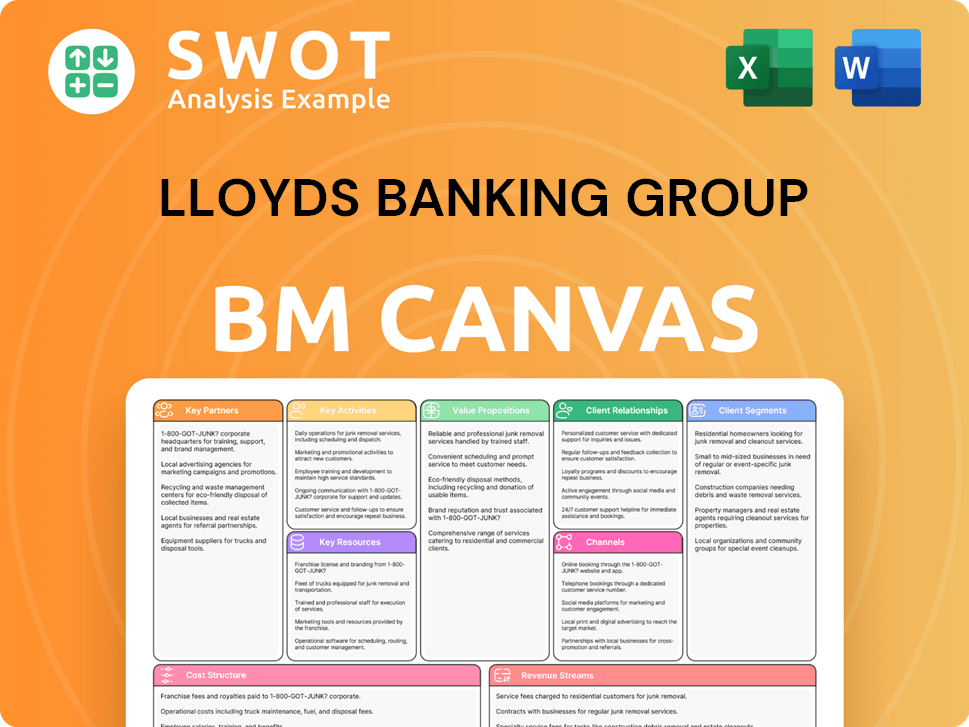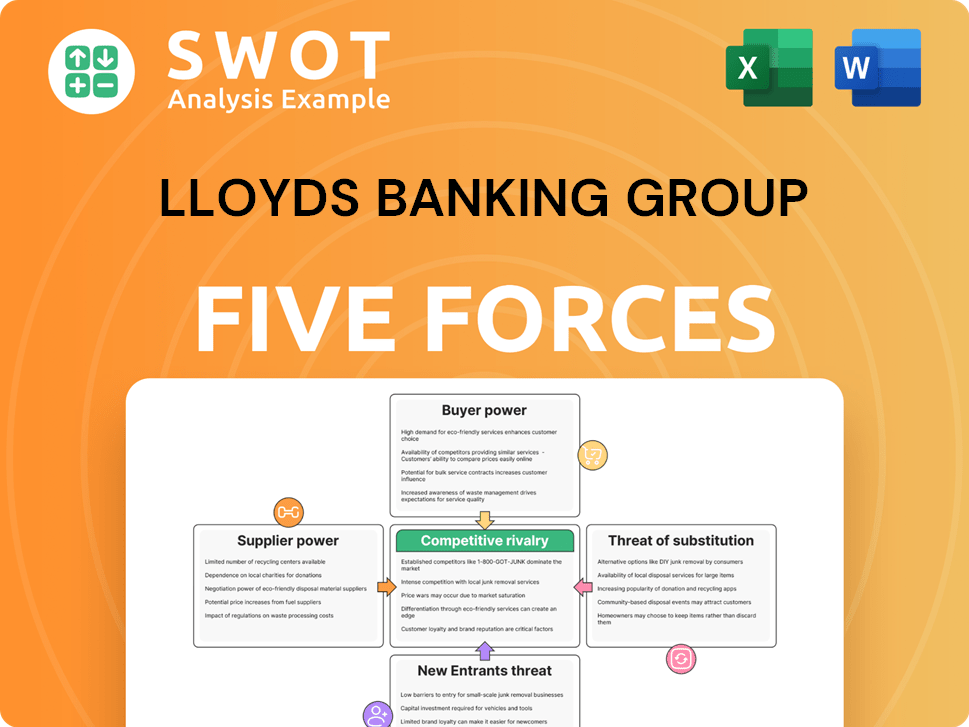Lloyds Banking Group Bundle
How Does Lloyds Banking Group Navigate the UK Banking Arena?
The UK banking sector is a battlefield of innovation and tradition, where giants like Lloyds Banking Group constantly adapt to survive. From its 1765 origins, Lloyds has witnessed centuries of financial evolution, growing into a cornerstone of the British economy. Understanding its competitive position is crucial for any investor or strategist navigating today's financial landscape.

This analysis dives deep into the Lloyds Banking Group SWOT Analysis, examining its market share, financial services competition, and strategic positioning within the UK banking sector. We'll explore who its primary rivals are and assess its competitive advantages, considering its financial performance and digital banking strategy. Furthermore, we'll investigate the impact of economic changes and regulatory environments on Lloyds Banking Group, providing a comprehensive view of its future competitive outlook.
Where Does Lloyds Banking Group’ Stand in the Current Market?
Lloyds Banking Group holds a prominent position within the UK financial services sector. Its core operations focus on retail and commercial banking, life, pensions, insurance, and wealth management. The group's value proposition centers on providing a comprehensive suite of financial products and services to a broad customer base, leveraging its extensive branch network and digital platforms.
The group's market position is solidified by its substantial customer base and significant market share. With a focus on the UK market, it serves a wide range of customers, from individuals and SMEs to large corporations. This strong domestic presence enables the group to maintain its competitive edge in the financial services competition.
As of its full-year 2024 results, Lloyds Banking Group reported a statutory profit after tax of £5.5 billion, demonstrating robust financial health. The group's strategic investments in digital capabilities, with 21.6 million digital active users in 2024, reflect its commitment to evolving customer needs. The Brief History of Lloyds Banking Group provides further insights into its evolution and strategic direction.
Lloyds Banking Group holds a significant market share in the UK's current account market, estimated at around 20%. The group serves over 26 million customers across its various brands. Lloyds Bank alone serves approximately 15 million customers, highlighting its strong reach within the UK banking sector.
The group's financial performance in 2024 included a mortgage book of £298 billion as of December 31, 2024. The common equity tier 1 (CET1) ratio stood at 13.7% in 2024, indicating a strong capital position. This strong capital position allows for continued investment and strategic maneuvers.
Lloyds offers a diverse range of products, including retail banking, commercial banking, and wealth management. Key offerings include current accounts, mortgages, personal loans, and services for businesses. The group's products are designed to meet the broad financial needs of its customers.
Lloyds has invested heavily in digital capabilities to improve customer experience and efficiency. Digital active users reached 21.6 million in 2024, showing a shift towards accessible banking services. The group's strategy focuses on adapting to evolving customer needs and competitive pressures.
Lloyds Banking Group's competitive advantages stem from its extensive customer base, strong market share in core banking products, and robust financial performance. Its focus on the UK market allows it to maintain a strong presence.
- Extensive branch network and digital platforms.
- Significant market share in current accounts and mortgages.
- Strong capital position with a CET1 ratio of 13.7% in 2024.
- Diverse product offerings across retail, commercial, and wealth management.
Lloyds Banking Group SWOT Analysis
- Complete SWOT Breakdown
- Fully Customizable
- Editable in Excel & Word
- Professional Formatting
- Investor-Ready Format

Who Are the Main Competitors Challenging Lloyds Banking Group?
The competitive landscape for Lloyds Banking Group (LBG) is complex, with a wide array of competitors across its various business segments. The banking industry analysis reveals a dynamic environment shaped by traditional players, challenger banks, and fintech companies. Understanding these competitive forces is crucial for assessing LBG's market position and future prospects.
LBG faces competition in retail and commercial banking, wealth management, and insurance. The UK banking sector is particularly competitive, with established banks vying for market share. Furthermore, the rise of digital banking and fintech innovations has intensified the competition, requiring LBG to adapt and innovate to maintain its position.
The competitive dynamics also involve pricing strategies, digital offerings, and customer service. LBG's ability to navigate these challenges will be key to its continued success. For more information about the company, you can read Owners & Shareholders of Lloyds Banking Group.
NatWest Group, Barclays, and HSBC are the primary direct competitors. They compete on product offerings, digital innovation, and geographical reach. These banks have a strong presence in both retail and commercial banking, posing a significant challenge to LBG.
Digital-only banks like Monzo, Starling Bank, and Revolut are gaining market share, especially among younger demographics. These fintech companies offer innovative features and competitive pricing, challenging LBG's established model. They focus on digital-first customer experiences.
Supermarkets and other non-traditional financial service providers are entering the market. They offer basic banking services and credit products, broadening the competitive landscape. This increases the pressure on traditional banks to diversify and innovate.
Intense competition in the mortgage market drives banks to adjust rates to attract and retain customers. This is a key area of competition, with banks continuously vying for the best rates and terms. The mortgage market is highly sensitive to economic changes.
LBG's Scottish Widows brand competes with independent financial advisors, investment platforms, and wealth management arms of other banks. This segment is highly competitive, with a focus on personalized financial advice and investment management services. The competition includes both traditional and digital wealth management platforms.
Mergers and partnerships in the fintech space continually reshape the competitive dynamics. LBG must remain agile and responsive to these market shifts. These strategic moves can significantly alter the competitive landscape.
Several factors influence the competitive landscape, including pricing, digital innovation, customer service, and regulatory compliance. LBG's ability to excel in these areas will determine its market share and long-term success. The financial services competition is fierce, and LBG must continually adapt to remain competitive.
- Pricing: Competitive interest rates on mortgages and savings accounts.
- Digital Innovation: User-friendly mobile apps and online banking platforms.
- Customer Service: High-quality customer support and personalized services.
- Regulatory Compliance: Adherence to financial regulations and industry standards.
Lloyds Banking Group PESTLE Analysis
- Covers All 6 PESTLE Categories
- No Research Needed – Save Hours of Work
- Built by Experts, Trusted by Consultants
- Instant Download, Ready to Use
- 100% Editable, Fully Customizable

What Gives Lloyds Banking Group a Competitive Edge Over Its Rivals?
Analyzing the Lloyds Banking Group's competitive landscape reveals a complex interplay of strengths and challenges within the UK banking sector. The group's enduring presence and strategic initiatives shape its market position, influencing its ability to compete effectively. Understanding these dynamics is crucial for assessing its future prospects and performance relative to its rivals.
Lloyds Banking Group has navigated significant shifts in the financial services competition. Its strategic moves, including digital transformation and customer-centric approaches, have been pivotal. These actions have allowed it to maintain a competitive edge, although the market is always changing.
The banking industry analysis shows that Lloyds Banking Group faces ongoing pressure from both traditional competitors and emerging fintech firms. Its ability to adapt to these changes will determine its long-term success. For a detailed look at the group's customer base, consider reviewing the Target Market of Lloyds Banking Group.
Lloyds Banking Group benefits from strong brand recognition and customer loyalty. Brands like Lloyds Bank, Halifax, and Bank of Scotland are well-established in the UK. This trust translates into a substantial customer base, providing a stable foundation for operations.
The group maintains a significant physical branch presence alongside a growing digital footprint. While the physical network is shrinking, it still offers a tangible point of contact. Digital platforms serve a broad range of customer preferences, creating a hybrid model.
As one of the largest financial services groups in the UK, Lloyds Banking Group achieves lower operating costs. This scale allows for significant investment in technology and infrastructure. It also enables favorable terms with suppliers.
Lloyds Banking Group has an integrated business model spanning retail, commercial, insurance, and wealth management. This model allows for cross-selling opportunities and comprehensive customer relationships. This approach strengthens its market position.
Lloyds Banking Group's competitive advantages include strong brand recognition, an extensive distribution network, and economies of scale. These factors contribute to its ability to maintain a significant market share. The group's financial performance reflects these strengths, with a strong CET1 ratio of 13.7% in 2024.
- Brand Recognition: Strong brands like Lloyds Bank, Halifax, and Bank of Scotland foster trust.
- Customer Base: Over 26 million customers provide a stable foundation.
- Digital Presence: 21.6 million digital active users as of 2024.
- Financial Strength: A robust capital base supports strategic growth.
Lloyds Banking Group Business Model Canvas
- Complete 9-Block Business Model Canvas
- Effortlessly Communicate Your Business Strategy
- Investor-Ready BMC Format
- 100% Editable and Customizable
- Clear and Structured Layout

What Industry Trends Are Reshaping Lloyds Banking Group’s Competitive Landscape?
The UK banking sector is currently undergoing significant transformation, impacting the competitive landscape for major players like Lloyds Banking Group. Key trends include the rise of digital banking, increasing regulatory scrutiny, and evolving customer expectations. Understanding these dynamics is crucial for assessing Lloyds' market position and future prospects. This Revenue Streams & Business Model of Lloyds Banking Group analysis provides further insights into the company's operations.
Lloyds faces both challenges and opportunities within this evolving environment. The rise of fintechs and challenger banks intensifies competition, while the need for digital transformation and compliance with new regulations adds complexity. Simultaneously, advancements in technology and changing consumer preferences offer avenues for growth and innovation. The company's strategic responses to these factors will determine its success in the coming years.
The banking industry is seeing rapid technological advancements, including AI, cloud computing, and open banking. Embedded finance and BaaS models are also emerging, potentially disrupting traditional banking. Regulatory changes focusing on consumer duty and financial resilience are ongoing. Consumer preferences are shifting towards digital, personalized services.
Increased competition from fintechs and challenger banks puts pressure on digital transformation. Cybersecurity threats and the rising cost of living pose risks to operational resilience and customer financial health. The cost and complexity of investing in technology are significant for established institutions like Lloyds.
Continued growth in digital adoption, with Lloyds' digital active users reaching 21.6 million, offers expanded reach and reduced costs. Data analytics and AI can enhance customer engagement and loyalty through tailored services. Environmental, Social, and Governance (ESG) factors provide opportunities to attract investors and customers. Expanding wealth management services is also a key area for growth.
Lloyds is investing significantly to maintain its competitive position. The company's investment of £3 billion in strategic initiatives, as outlined in its 2024 full-year results, demonstrates a proactive approach. This investment aims to ensure resilience in a dynamic environment and drive future growth.
The competitive landscape for Lloyds Banking Group is shaped by digital transformation, regulatory changes, and evolving customer expectations. These factors require strategic responses in technology, risk management, and customer service. Lloyds' ability to adapt and innovate will determine its future success in the UK banking sector.
- Enhancing digital banking platforms to compete with fintechs.
- Investing in cybersecurity to mitigate increasing threats.
- Leveraging data analytics to personalize customer experiences.
- Expanding wealth management and ESG-focused offerings.
Lloyds Banking Group Porter's Five Forces Analysis
- Covers All 5 Competitive Forces in Detail
- Structured for Consultants, Students, and Founders
- 100% Editable in Microsoft Word & Excel
- Instant Digital Download – Use Immediately
- Compatible with Mac & PC – Fully Unlocked

Related Blogs
- What are Mission Vision & Core Values of Lloyds Banking Group Company?
- What is Growth Strategy and Future Prospects of Lloyds Banking Group Company?
- How Does Lloyds Banking Group Company Work?
- What is Sales and Marketing Strategy of Lloyds Banking Group Company?
- What is Brief History of Lloyds Banking Group Company?
- Who Owns Lloyds Banking Group Company?
- What is Customer Demographics and Target Market of Lloyds Banking Group Company?
Disclaimer
All information, articles, and product details provided on this website are for general informational and educational purposes only. We do not claim any ownership over, nor do we intend to infringe upon, any trademarks, copyrights, logos, brand names, or other intellectual property mentioned or depicted on this site. Such intellectual property remains the property of its respective owners, and any references here are made solely for identification or informational purposes, without implying any affiliation, endorsement, or partnership.
We make no representations or warranties, express or implied, regarding the accuracy, completeness, or suitability of any content or products presented. Nothing on this website should be construed as legal, tax, investment, financial, medical, or other professional advice. In addition, no part of this site—including articles or product references—constitutes a solicitation, recommendation, endorsement, advertisement, or offer to buy or sell any securities, franchises, or other financial instruments, particularly in jurisdictions where such activity would be unlawful.
All content is of a general nature and may not address the specific circumstances of any individual or entity. It is not a substitute for professional advice or services. Any actions you take based on the information provided here are strictly at your own risk. You accept full responsibility for any decisions or outcomes arising from your use of this website and agree to release us from any liability in connection with your use of, or reliance upon, the content or products found herein.